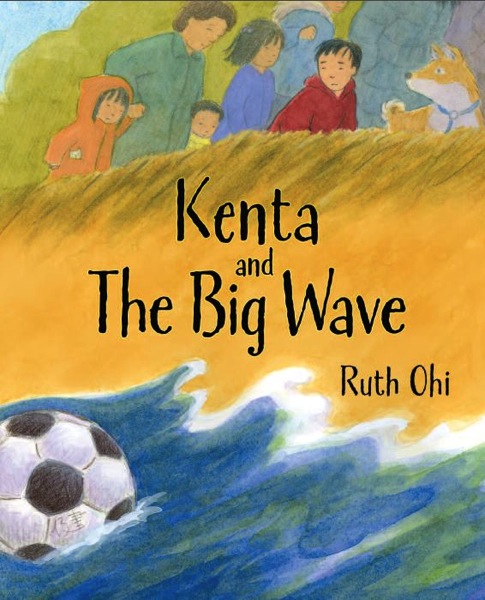Kenta and the Big Wave by Ruth Ohi
 “When Kenta heard the warning siren, he ran to school … far up the hill, where the waves couldn’t reach.” He watches his soccer ball roll away, but thankfully finds his parents in the gym. When the ocean finally “fell back to where it belonged,” the devastation proves shocking: “‘Everything … gone,'” Kenta’s mother says, echoing the thoughts of everyone around them. Kenta manages to fashion a new ball out of scraps, but “[n]ot all things could be fixed so easily.”
“When Kenta heard the warning siren, he ran to school … far up the hill, where the waves couldn’t reach.” He watches his soccer ball roll away, but thankfully finds his parents in the gym. When the ocean finally “fell back to where it belonged,” the devastation proves shocking: “‘Everything … gone,'” Kenta’s mother says, echoing the thoughts of everyone around them. Kenta manages to fashion a new ball out of scraps, but “[n]ot all things could be fixed so easily.”
Meanwhile, on the shores of the powerful ocean on the other side of the world, Kenta’s ball rolls up on a faraway beach. “[T]he boy could not understand Kenta’s writing,” but he resourcefully finds someone who can. With the help of a librarian, the boy is able to send Kenta’s ball back home.
Veteran Canadian author/illustrator Ruth Ohi explains in her ending “Author’s Note” that Kenta is “based on the true stories reported in the news following the [Tōhoku, Japan] tsunami of 2011, about objects (some as large as motorcycles!) being swept away in the storm’s waves and washing up on the shore all the way on the other side of the world.” Another Ruth – Ozeki – published an engrossing adult novel earlier this year, A Tale for the Time Being, also about what the waves washed up, bridging unlikely connections across thousands of miles. Both Ruths’ titles are important, necessary reminders that in spite of tragedies of such unfathomable magnitude, the world turns out to be not so vast, and the smallest shared moments can bind unknown individuals together in the most compassionate, tender ways.
One minor quibble: the single character visible on the ball is only the first kanji of Kenta’s name – 健 (meaning ‘healthy,’ ‘strong’) – and written a bit too widely spaced to be fully accurate. The -ta (太, meaning ‘large,’ ‘big’) is never visible, making the name always incomplete. I can’t figure out if this was an inexplicable stylistic choice or an actual error. That said, one tiny flaw can’t spoil this whole hopeful story. The more important message of connection and caring – a young man carrying an elderly woman on his back as the wind gains greater force, survivors huddling to comfort one another in the colossal wreckage, children somehow finding the ability to laugh and play even in tragedy – rings loudly throughout Ohi’s soft, gentle illustrations on every page.
Readers: Children
Published: 2013
Sorry, the comment form is closed at this time.

Discussion